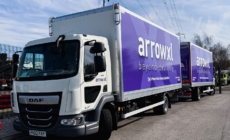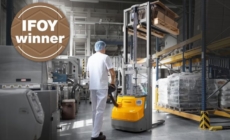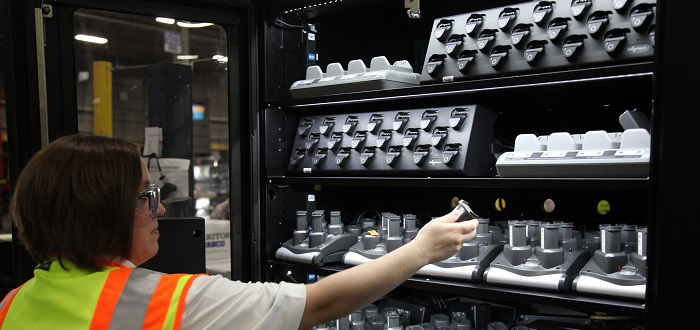-
ROSSLARE EUROPORT TARGETS HEALTH & SAFETY WITH CAMERA TELEMATICS PARTNERSHIP - 2 days ago
-
Landmark Study Reveals Wearable Robotics Significantly Boost Safety and Efficiency in Industrial Environments - July 24, 2024
-
Visku Tackle The Retail Seasonality Challenge One Pallet At A Time - July 22, 2024
-
KAMMAC AND BERGEN LOGISTICS STRENGTHEN FASHION & LIFESTYLE SERVICES IN THE UK - July 19, 2024
-
TENTBOX EXTENDS PARTNERSHIP WITH ARROWXL TO SUPPORT INCREASING DEMAND - July 17, 2024
-
The Perfume Shop improves customer journeys while driving profitability in partnership with Scurri - July 17, 2024
-
ZEROMISSION SECURES £2.3M ($3M) INVESTMENT TO ACCELERATE ELECTRIC FLEETS - July 16, 2024
-
BCMPA CELEBRATES SUCCESS OF 2024 CONFERENCE - July 15, 2024
-
Best of the Best: Jungheinrich Celebrates Triple International Award Win - July 12, 2024
-
GOPLASTICPALLETS.COM CALLS ON NEW CHANCELLOR RACHEL REEVES TO CONSIDER PLASTIC PACKAGING TAX REFORM - July 10, 2024
MERITOR’S ASSET MANAGEMENT PROGRAM KEEPS DISTRIBUTION HUB RUNNING SMOOTHLY
Fulfilling customer orders at Meritor’s 440,000-square-foot distribution facility in Florence, Kentucky is critical. It’s the primary distribution centre for Meritor’s global aftermarket business.
Keeping this facility working at full capacity requires hundreds of employees across two shifts, armed with scanners, voice picking equipment, mobile printers and deftly operating an array of material handling trucks. When it was time to upgrade the facility’s warehouse management system (WMS) and its pool of handheld scanners, Meritor knew that finding a better approach to managing its handheld equipment and scanner batteries was critical.
“With scanners and batteries frequently being misplaced or accidentally damaged, we needed a way to contain the cost of managing this valuable equipment and increasing employee productivity,” said Steve Ammerman, director of Operations and Industrialisation. “We knew that we needed a system to track the scanners and batteries while also building in employee accountability.”
Making Sure the People and Equipment are in Place
Meritor wanted a solution to alert itself when scanners were misplaced or damaged so they could be returned to service quickly.
“Ultimately, we wanted to improve our asset management and boost efficiency,” said Jason Back, Meritor’s WMS project manager. “We had been dedicating people to track down scanners and batteries that were being left in workspaces, on lift trucks, in pallet racks and storage bins. In our fast-paced warehouse, we have to make sure everyone on each shift has a scanner and that nobody is idle. We need our people and equipment in place to complete all of our tasks on schedule.”
Meritor was also looking for ways to improve its battery management. Batteries were often removed from chargers not fully charged. Because of this, employees had to change batteries an average of every two hours and stockpiled batteries to get through a shift without having to get more. Without charging batteries fully each time, the lifecycle of each one became shorter.
Asset Management Impacts Operations
Fortunately, Meritor had been documenting the operational impact of the old approach to asset management at the Florence facility:
• Longer walk-and-wait time: Two employees spent a half day in total on walk-and-wait time on a near-daily basis.
• Shorter battery life: Inconsistent use shortened battery life, meaning batteries had to be purchased more frequently.
• Escalating loss, damage and repair rates: Scanner turnover rate due to damage and repairs was at an ultimate high.
Meritor considered staffing a tool crib to manage the equipment. But this would require additional resources to manage the check-out and check-in processes across two shifts. And it would only add time to the shift start-up process.
The Easiest Solution is Usually the Best
A simpler, more cost-effective solution was found in Apex Supply Chain Technologies®. Meritor deployed four AXCESS™ 6000 asset management lockers for its handheld devices and a MegaStore™9500 high-density dispensing system for battery management.
All of these devices rely on the Apex Trajectory Cloud™ inventory tracking platform to give Meritor’s employees full visibility of their assets at all times. Trajectory captures the check-in and check-out of each device, reporting on usage patterns and sending automated email alerts to notify Brittany Brock, Meritor’s asset control technician, if equipment is not returned or it is damaged.
Now, damaged scanners are only out of service for a few days instead of a few weeks when they’re sent out for repair. And if an employee has equipment out for more than 12 hours, Brock gets an email alert and can follow up with the specific employee. This has eliminated the walk-and-wait time at the beginning of each shift.
“Trajectory’s overdue asset alerts and asset return status alerts have given hours back to my day,” says Brock. “It makes employees accountable and gives them an easy way to report damaged equipment. This has helped shorten our response time significantly and made everyone more productive.”
Point-of-Use Eliminates Walk & Wait
“The Apex devices were deployed in three areas of the warehouse where teams meet to start their shifts,” said Brock. “Teams were leery of the new solution at first. But the devices and Trajectory are very easy to learn and usually only take one walkthrough to understand. After checking out a device for the first time, employees realise how easy the process is and how much more quickly it can get them onto the floor.”
Brock customises access for each employee based on their job responsibilities to ensure they can only access the tools needed to do their specific job. Employees use their security cards to access the Apex devices so new cards were not needed.
Battery Management with MegaStore™
Using the MegaStore™ cabinet and drawer combination helps Meritor easily manage its batteries and chargers. All batteries charge in the cabinet while individual drawers keep drained and fully charged batteries separate. Except for a few lead technicians tasked with charging batteries, most employees can only get into the drawers.
“We know if employees are draining the batteries fully before turning them in or if they’re taking more than one battery,” says Brock. “Battery stockpiling has been eliminated along with the need to train employees on proper charging. This cuts down on employee frustration and helps productivity.”
The Apex devices have helped Meritor extend the battery life of all its scanner equipment. And because of this, Brock has saved money by being able to purchase fewer batteries.
Extend Access to Increase Impact & Benefits
With the Apex devices online for nearly a year, Meritor is finding new ways to help eliminate friction and increase employee time on the floor.
“The locker compartments are versatile and able to store whatever our employees might need on a daily basis,” says Brock. “In some lockers, we are now maintaining knives, tapers and banders used in the value-added services department,” says Brock. “Employees open their locker; get supplies and devices customized for their job description and go. And the containers can be shared across shifts.”
The benefits the Apex devices have brought to Meritor seem to build on one another. Downtime decreases and productivity increases along with equipment utilisation rates. By increasing equipment utilisation, costs are reduced.
And by giving employees easy access to the tools they need to do their job, when and where they need it, team frustrations are eliminated and morale improves. It’s no wonder Meritor’s asset management program is a popular demonstration when visitors tour the facility.

































